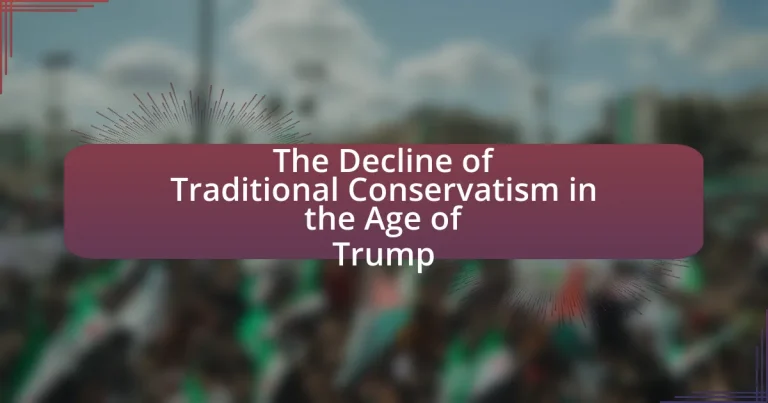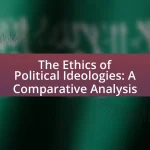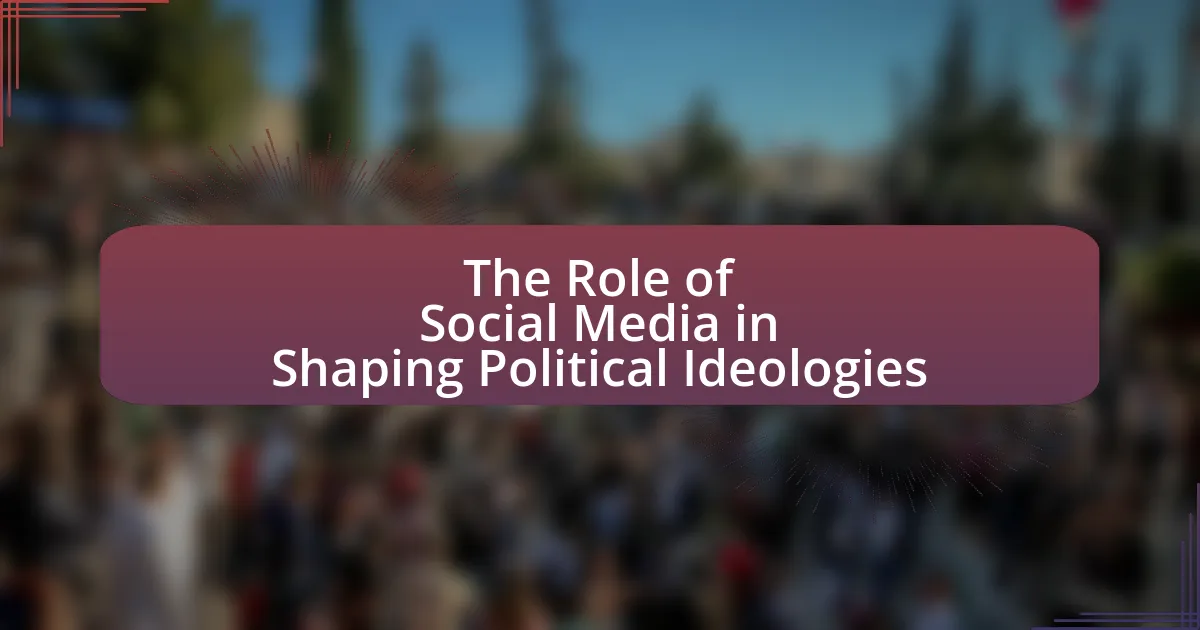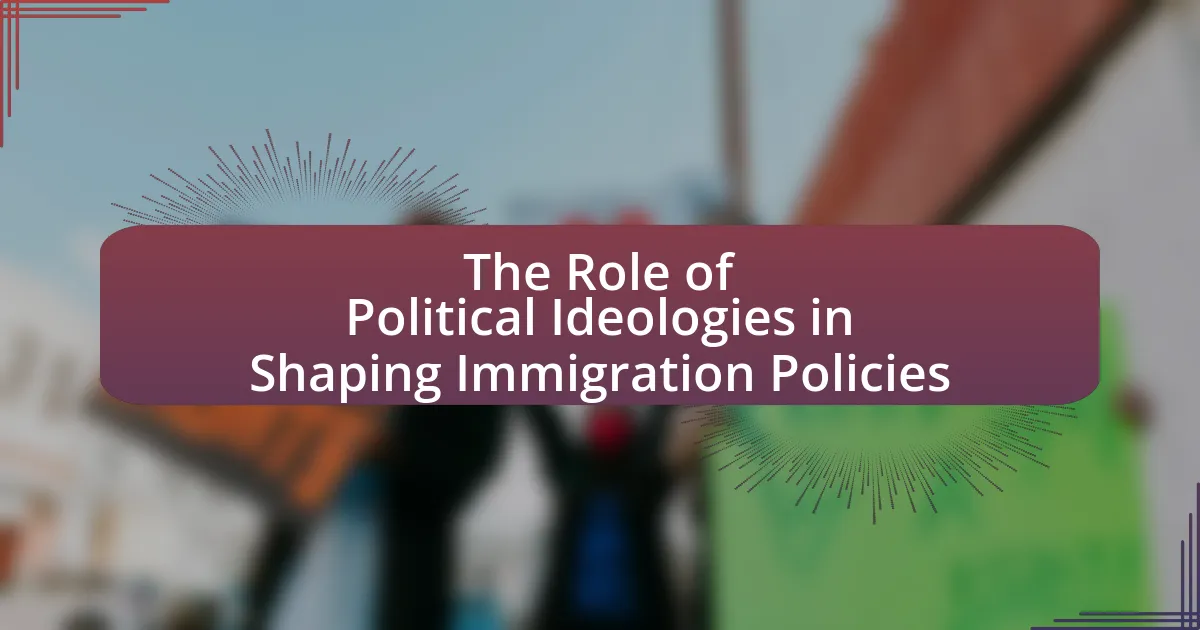The article examines the decline of traditional conservatism in the United States during the presidency of Donald Trump, highlighting a significant shift from established conservative principles towards populism and nationalism. It discusses how Trump’s anti-establishment rhetoric, protectionist policies, and identity politics have reshaped the Republican Party, alienating traditional conservatives who value ideological consistency. The piece also explores the historical evolution of conservatism, the impact of demographic changes, and the role of social media in amplifying Trump’s message, ultimately addressing the implications of this decline for the future of American political discourse and the Republican Party.
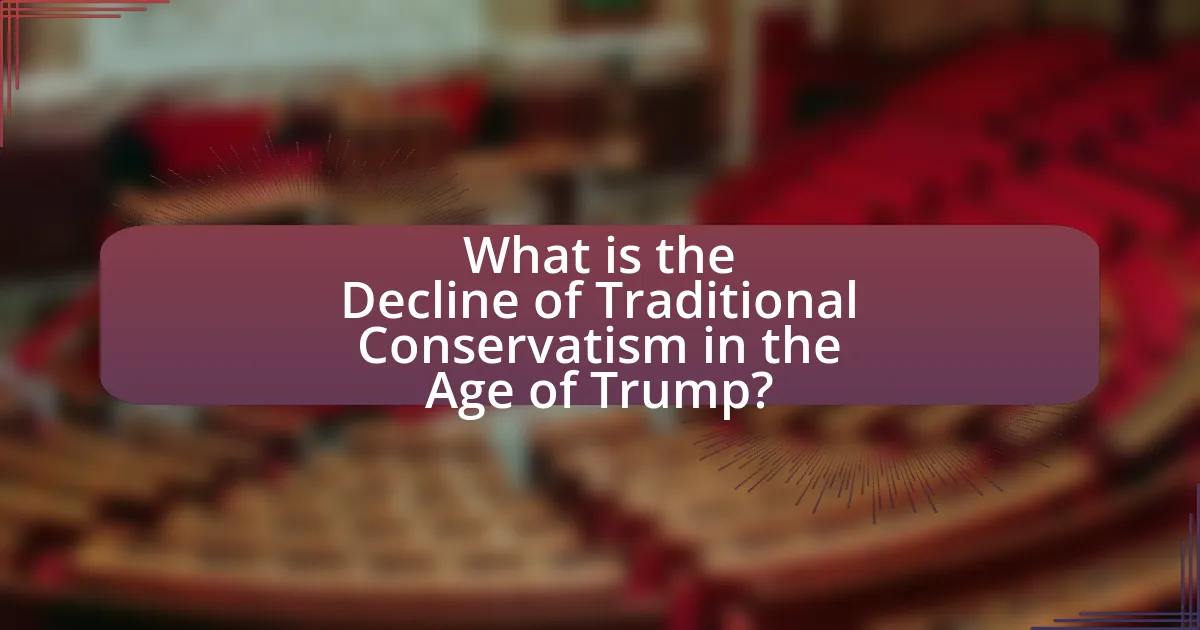
What is the Decline of Traditional Conservatism in the Age of Trump?
The decline of traditional conservatism in the age of Trump is characterized by a shift away from established conservative principles towards populism and nationalism. Traditional conservatism, which emphasizes limited government, free markets, and individual liberties, has been overshadowed by Trump’s focus on anti-establishment rhetoric, protectionist policies, and identity politics. This transformation is evident in the Republican Party’s embrace of Trump’s unconventional style and policies, which have attracted a new base of voters while alienating traditional conservatives who prioritize ideological consistency. The 2016 election and subsequent political developments illustrate this decline, as many long-standing conservative figures and institutions have struggled to reconcile their values with the populist direction of the party under Trump’s influence.
How has the definition of traditional conservatism evolved over time?
The definition of traditional conservatism has evolved from a focus on preserving established institutions and values to a more populist and nationalist approach. Historically, traditional conservatism emphasized limited government, individual liberties, and the importance of social order, as seen in the writings of Edmund Burke in the 18th century. However, in recent decades, particularly during the rise of the Tea Party and the Trump administration, the definition has shifted to prioritize anti-establishment sentiments, economic protectionism, and a strong national identity. This transformation is evidenced by the increasing acceptance of rhetoric that challenges established norms and institutions, reflecting a broader cultural and political realignment within the conservative movement.
What historical factors contributed to the establishment of traditional conservatism?
The establishment of traditional conservatism was primarily influenced by the reaction to the French Revolution and the Industrial Revolution. The French Revolution, which began in 1789, instigated a backlash among European elites who feared the rise of radical egalitarianism and the erosion of established social hierarchies. This led to the development of conservative thought that emphasized the importance of tradition, social order, and gradual change rather than revolutionary upheaval.
Additionally, the Industrial Revolution, which transformed economies and societies in the 18th and 19th centuries, prompted concerns about the rapid social changes and the dislocation of communities. Conservatives advocated for the preservation of established institutions, such as the monarchy and the church, as stabilizing forces in society. These historical factors collectively shaped the foundational principles of traditional conservatism, emphasizing continuity, authority, and the value of inherited wisdom.
How did traditional conservatism manifest in American politics before Trump?
Traditional conservatism in American politics before Trump manifested through a commitment to limited government, fiscal responsibility, and a strong national defense. This ideology was prominently represented by figures such as Ronald Reagan, who emphasized tax cuts, deregulation, and a robust military presence during the Cold War. The Republican Party, under Reagan’s influence, adopted policies that prioritized free-market principles and traditional social values, reflecting a desire to maintain established norms and resist rapid change. Additionally, traditional conservatism was characterized by a focus on individual liberties and personal responsibility, as seen in the promotion of the “Contract with America” in the 1990s, which aimed to reduce the size of government and promote conservative social policies. These elements collectively shaped the political landscape, reinforcing a conservative identity that valued stability and continuity in governance.
What role did Donald Trump play in the transformation of conservatism?
Donald Trump played a pivotal role in the transformation of conservatism by shifting its focus from traditional principles to a populist, nationalist agenda. His presidency marked a departure from established conservative values, emphasizing issues such as immigration control, trade protectionism, and a strong anti-establishment rhetoric. This shift was evident in the 2016 election, where Trump garnered significant support by appealing to working-class voters disillusioned with the political elite, thereby redefining the Republican Party’s base. Additionally, Trump’s use of social media to communicate directly with supporters bypassed traditional media channels, further solidifying his influence on the conservative movement. This transformation has led to a re-evaluation of what it means to be conservative in the United States, as evidenced by the rise of candidates and policies that align more closely with Trump’s vision than with traditional conservative ideologies.
How did Trump’s policies differ from traditional conservative values?
Trump’s policies diverged from traditional conservative values primarily through a focus on populism, nationalism, and a departure from free trade principles. Traditional conservatism emphasizes limited government, fiscal responsibility, and free-market economics, whereas Trump’s administration prioritized protectionist trade policies, such as tariffs on imports, which contradicted the longstanding conservative advocacy for free trade. Additionally, Trump’s approach to immigration, characterized by strict enforcement and a border wall initiative, marked a shift towards a more nationalist stance, contrasting with the traditional conservative view that often supported legal immigration and assimilation. Furthermore, Trump’s rhetoric and policies often favored direct appeals to the electorate over established party norms, reflecting a populist approach that prioritized the interests of his base over traditional conservative alliances.
What impact did Trump’s rhetoric have on the conservative base?
Trump’s rhetoric significantly energized the conservative base, leading to increased political engagement and loyalty among supporters. His use of populist language and direct communication style resonated with many conservatives, fostering a sense of identity and urgency around issues such as immigration, trade, and nationalism. This shift is evidenced by the rise in voter turnout among conservative demographics during the 2016 and 2020 elections, where Trump’s messaging mobilized previously disengaged voters. Additionally, polls indicated that a substantial portion of the conservative base felt more aligned with the Republican Party under Trump’s leadership, reflecting a transformation in party dynamics and priorities.
Why is the decline of traditional conservatism significant?
The decline of traditional conservatism is significant because it marks a shift in the ideological landscape of the Republican Party and American politics. This shift has led to the rise of populist and nationalist sentiments, which have redefined party priorities and voter bases. For instance, traditional conservatism emphasized limited government, fiscal responsibility, and free markets, while the current trend often prioritizes identity politics and anti-establishment rhetoric. This transformation is evidenced by the 2016 election, where Donald Trump’s candidacy attracted a substantial portion of voters who felt alienated by conventional conservative policies, indicating a departure from established norms. The implications of this decline affect policy-making, party unity, and the overall direction of American governance.
What are the potential consequences for the Republican Party?
The potential consequences for the Republican Party include a fragmentation of its voter base and a shift towards more extreme positions. This fragmentation is evidenced by the increasing divide between traditional conservatives and populist factions, which has led to challenges in unifying the party for elections. For instance, in the 2020 election, the party saw a significant split in support, with traditional conservatives expressing concerns over Trump’s policies and rhetoric, resulting in lower turnout among moderate voters. Additionally, the embrace of populism may alienate centrist voters, impacting the party’s ability to win in swing states, as seen in the 2022 midterm elections where moderate candidates struggled against more extreme primary challengers.
How might this decline affect American political discourse?
The decline of traditional conservatism may lead to increased polarization in American political discourse. As traditional conservative values diminish, factions within the Republican Party may become more extreme, resulting in a shift towards populism and nationalism. This shift can create a more divisive political environment, as moderate voices are marginalized and ideological purity becomes prioritized. Historical trends indicate that such polarization can lead to a breakdown in bipartisan cooperation, as seen during the rise of the Tea Party movement, which significantly altered the dynamics of political negotiation and compromise in Congress.
What factors contributed to the decline of traditional conservatism during Trump’s presidency?
The decline of traditional conservatism during Trump’s presidency was primarily driven by the rise of populism and the shift towards a more nationalist agenda. Traditional conservative values, which emphasized limited government, free markets, and international alliances, were overshadowed by Trump’s focus on anti-establishment rhetoric and protectionist policies. This shift alienated many traditional conservatives who prioritized fiscal responsibility and global engagement. Additionally, the embrace of divisive social issues and the prioritization of loyalty to Trump over party principles further fragmented the conservative base, leading to a significant departure from established conservative norms.
How did populism influence the conservative movement?
Populism significantly influenced the conservative movement by shifting its focus towards anti-establishment sentiments and prioritizing the concerns of the “common people.” This transformation became evident during the rise of Donald Trump, who capitalized on populist rhetoric to attract a broader base of support, emphasizing nationalism and skepticism towards elites. The 2016 election showcased how populist themes resonated with conservative voters, leading to a departure from traditional conservative principles, such as free trade and internationalism, in favor of protectionist policies and a more isolationist foreign policy. This shift is supported by the fact that Trump’s platform included promises to renegotiate trade deals and restrict immigration, which appealed to voters feeling left behind by globalization and economic change.
What are the characteristics of populism that appealed to conservative voters?
Populism appealed to conservative voters through its emphasis on nationalism, anti-elitism, and a focus on the concerns of the “common people.” Nationalism resonated with conservative voters who prioritized sovereignty and cultural identity, often reacting against globalization and immigration. Anti-elitism attracted those who felt marginalized by political establishments, as populist leaders positioned themselves as champions of the ordinary citizen against corrupt elites. Additionally, the populist narrative often included a strong stance on law and order, appealing to conservative values around security and stability. These characteristics were evident in the rise of figures like Donald Trump, who utilized these themes to galvanize support among conservative voters, evidenced by his significant electoral success in 2016.
How did populism reshape the priorities of the Republican Party?
Populism reshaped the priorities of the Republican Party by shifting its focus from traditional conservative values to a more nationalist and anti-establishment agenda. This transformation became evident during Donald Trump’s 2016 presidential campaign, where he emphasized themes such as economic protectionism, immigration restriction, and a critique of political elites. The Republican Party began prioritizing the concerns of working-class voters, particularly in rural areas, over the interests of traditional conservative constituencies, such as big business and fiscal conservatism. This shift was reflected in policy changes, such as tariffs on imports and a more aggressive stance on immigration, which resonated with a base that felt neglected by the political establishment.
What role did social media play in the decline of traditional conservatism?
Social media significantly contributed to the decline of traditional conservatism by facilitating the rise of populist and extremist ideologies that diverged from established conservative principles. Platforms like Twitter and Facebook enabled rapid dissemination of information, allowing fringe voices to gain visibility and influence, often overshadowing traditional conservative narratives. For instance, during the 2016 U.S. presidential election, social media was instrumental in promoting Donald Trump’s populist message, which appealed to disaffected voters and marginalized traditional conservative figures. This shift is evidenced by the fact that many traditional conservative leaders struggled to maintain relevance as social media amplified the reach of more radical viewpoints, leading to a fragmentation of the conservative base.
How did social media platforms amplify Trump’s message?
Social media platforms amplified Trump’s message by providing him with direct access to millions of users, allowing for rapid dissemination of his ideas and policies. The platforms enabled Trump to bypass traditional media filters, facilitating unmediated communication that resonated with his base. For instance, during the 2016 election, Trump’s use of Twitter allowed him to communicate directly with supporters, resulting in over 10 million followers by election day, which significantly increased his visibility and engagement. Additionally, algorithms on platforms like Facebook prioritized content that generated high engagement, further promoting Trump’s posts and messages, which often included provocative statements that sparked discussions and shares among users. This dynamic created a feedback loop, enhancing his reach and reinforcing his influence in the political landscape.
What impact did online communities have on conservative ideology?
Online communities significantly influenced conservative ideology by facilitating the spread of populist and nationalist sentiments. These platforms allowed for the rapid dissemination of ideas that diverged from traditional conservative values, promoting a more aggressive and confrontational political stance. For instance, the rise of social media during the Trump era enabled grassroots movements, such as the Tea Party and later, the alt-right, to gain traction and visibility, reshaping the conservative landscape. Research indicates that online forums and social media groups have become echo chambers, reinforcing extreme viewpoints and diminishing the influence of moderate conservatives, as evidenced by the increased polarization within the Republican Party.
How did demographic changes affect traditional conservatism?
Demographic changes significantly affected traditional conservatism by altering the voter base and shifting political priorities. As the United States experienced increasing diversity, particularly with the growth of Hispanic and Asian populations, traditional conservative values struggled to resonate with these groups, who often prioritize issues like immigration reform and social justice. For instance, the Pew Research Center reported that in 2020, 61% of Hispanic voters supported Joe Biden, indicating a departure from traditional conservative alignment. Additionally, younger voters, who tend to be more progressive on social issues, have increasingly favored candidates who align with their views, further challenging the traditional conservative platform. This demographic shift has led to a decline in the influence of traditional conservatism, as it has had to adapt to a more diverse electorate that often rejects its core tenets.
What shifts in voter demographics occurred during Trump’s presidency?
During Trump’s presidency, significant shifts in voter demographics included increased support from non-white voters, particularly among Hispanic and Black communities, while traditional white working-class support remained strong. In the 2016 election, Trump garnered 28% of the Hispanic vote, a notable increase from previous Republican candidates, and in 2020, he improved his share among Black voters to approximately 12%, compared to 8% in 2016. Additionally, suburban voters, especially women, showed a trend towards Democratic candidates in the 2018 midterms, indicating a shift in traditional voting patterns. These demographic changes reflect a complex realignment in American politics during Trump’s tenure.
How did these demographic changes challenge traditional conservative values?
Demographic changes, such as increasing racial and ethnic diversity, urbanization, and shifts in age distribution, have challenged traditional conservative values by altering the electorate’s priorities and perspectives. For instance, the growing influence of younger, more diverse voters has led to a greater emphasis on social issues like immigration reform, climate change, and LGBTQ+ rights, which often conflict with conservative stances. According to the Pew Research Center, between 2000 and 2020, the percentage of non-Hispanic white voters decreased from 75% to 58%, reflecting a significant demographic shift that has influenced political alignment and policy preferences. This transformation has prompted conservative parties to reassess their platforms to remain relevant in an evolving political landscape.
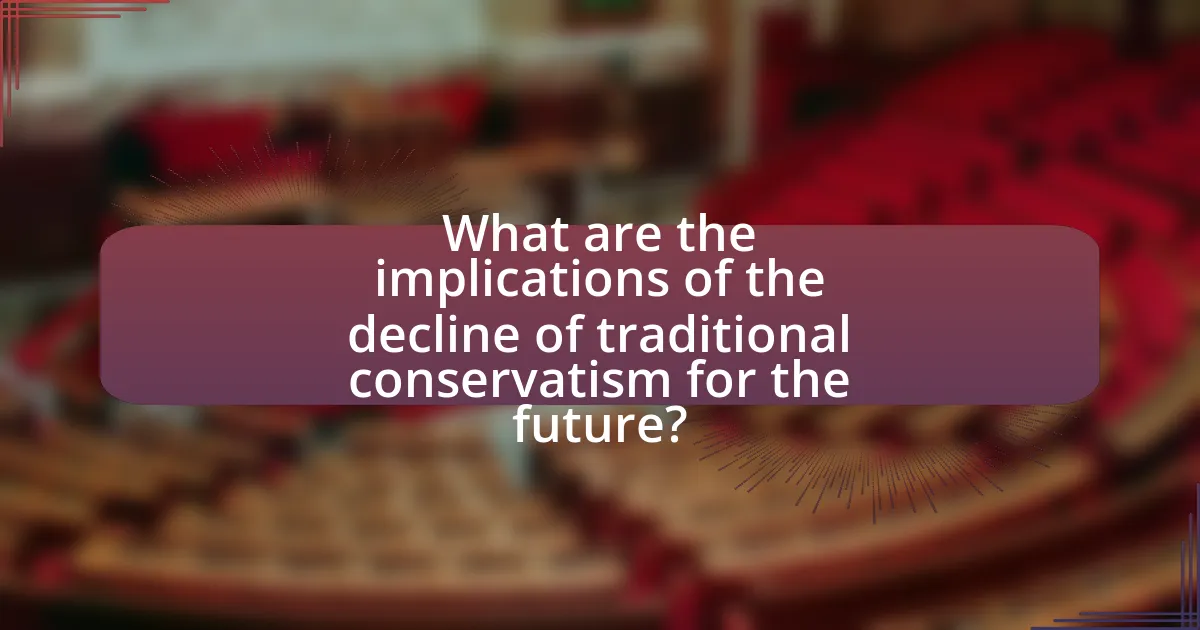
What are the implications of the decline of traditional conservatism for the future?
The decline of traditional conservatism implies a shift towards more populist and radical political ideologies, which can lead to increased polarization and instability in governance. As traditional conservative values, such as fiscal responsibility and limited government, lose influence, political parties may adopt more extreme positions to attract voters, resulting in a fragmented political landscape. This trend is evidenced by the rise of populist leaders who prioritize nationalism and anti-establishment sentiments over established conservative principles, as seen in the electoral successes of figures like Donald Trump. Consequently, the future may witness challenges in bipartisan cooperation, a decline in moderate political discourse, and potential disruptions to democratic norms.
What new forms of conservatism are emerging in the political landscape?
New forms of conservatism emerging in the political landscape include populist conservatism, nationalist conservatism, and digital conservatism. Populist conservatism, exemplified by figures like Donald Trump, emphasizes anti-establishment sentiments and appeals to the working class, often prioritizing national interests over traditional conservative values. Nationalist conservatism focuses on sovereignty and immigration control, reflecting a shift towards prioritizing national identity and security. Digital conservatism leverages social media and online platforms to mobilize support and disseminate conservative ideas, adapting to the changing communication landscape. These forms represent a departure from traditional conservatism, which historically emphasized limited government and free-market principles.
How do these new forms differ from traditional conservatism?
New forms of conservatism, particularly those emerging during the Trump era, differ from traditional conservatism primarily in their populist and nationalist rhetoric. Traditional conservatism typically emphasizes limited government, free markets, and individual liberties, whereas the new forms often prioritize identity politics, anti-establishment sentiments, and a more interventionist approach to trade and immigration. For example, Trump’s “America First” policy reflects a shift towards prioritizing national interests over global alliances, contrasting with the traditional conservative focus on internationalism and free trade. This divergence is evident in the growing acceptance of protectionist policies and a more aggressive stance on immigration, which traditional conservatives generally approached with a focus on legal frameworks and economic benefits.
What challenges do these new forms face in gaining mainstream acceptance?
New forms of conservatism face significant challenges in gaining mainstream acceptance, primarily due to ideological fragmentation and resistance from established party structures. The rise of populist movements has led to a divergence in conservative values, creating internal conflicts that weaken a unified front. Additionally, traditional conservative leaders often reject these new forms, viewing them as extreme or incompatible with established principles, which further alienates potential supporters. According to a 2020 Pew Research Center study, 62% of Republicans expressed concern that the party was becoming too extreme, highlighting the struggle for new forms to align with broader party identity and gain traction among the electorate.
How can traditional conservatives adapt to the changing political environment?
Traditional conservatives can adapt to the changing political environment by embracing a more inclusive and pragmatic approach to policy-making. This adaptation involves recognizing the shifting demographics and values of the electorate, which have increasingly favored progressive policies on issues such as healthcare, climate change, and social justice. For instance, a 2020 Pew Research Center study indicated that younger voters prioritize climate action and racial equality, suggesting that traditional conservative platforms may need to evolve to resonate with these concerns. By integrating these issues into their agenda, traditional conservatives can remain relevant and appeal to a broader base while maintaining core principles of fiscal responsibility and limited government.
What strategies can traditional conservatives employ to regain influence?
Traditional conservatives can regain influence by focusing on grassroots mobilization and fostering a unifying message that appeals to a broader base. By engaging local communities through town halls and community events, traditional conservatives can rebuild trust and connection with constituents. Additionally, emphasizing core conservative values such as fiscal responsibility, personal freedom, and strong national defense can resonate with voters who feel alienated by more extreme factions. Historical evidence shows that successful conservative movements, such as the Reagan era, thrived on clear communication of shared values and community engagement, which can serve as a model for current strategies.
How can traditional conservatism reconcile with the current political climate?
Traditional conservatism can reconcile with the current political climate by emphasizing its foundational principles of limited government, individual liberty, and fiscal responsibility while adapting to contemporary issues such as social justice and economic inequality. This approach allows traditional conservatives to engage with a broader electorate that is increasingly concerned about these issues, thereby maintaining relevance. For instance, traditional conservatives can advocate for market-based solutions to social problems, aligning with their values while addressing the demands of the current political landscape. Historical examples, such as the conservative movement’s adaptation during the Reagan era, demonstrate that embracing certain progressive ideas can enhance traditional conservatism’s appeal without compromising its core tenets.
What lessons can be learned from the decline of traditional conservatism?
The decline of traditional conservatism teaches the importance of adaptability and the need to address the evolving concerns of the electorate. Traditional conservatism, characterized by its emphasis on limited government, fiscal responsibility, and social stability, has struggled to resonate with voters who increasingly prioritize issues like social justice, climate change, and economic inequality. This shift is evidenced by the rise of populist movements that challenge established conservative norms, as seen in the 2016 U.S. presidential election where Donald Trump’s platform diverged significantly from traditional conservative values. The lesson here is that political ideologies must evolve to remain relevant, as failure to do so can lead to a loss of influence and support among the electorate.
How can political movements avoid similar declines in the future?
Political movements can avoid similar declines in the future by fostering adaptability and inclusivity within their platforms. Historical examples, such as the decline of traditional conservatism during the Trump era, illustrate that rigid ideologies can alienate potential supporters. Movements that embrace diverse perspectives and respond to changing societal values are more likely to maintain relevance. For instance, the Republican Party’s struggle to retain moderate voters during Trump’s presidency highlights the risks of extreme partisanship. By prioritizing a broad coalition and addressing the concerns of various demographics, political movements can enhance their resilience against decline.
What best practices can be adopted to maintain ideological integrity?
To maintain ideological integrity, individuals and organizations should establish clear principles and consistently adhere to them. This involves regularly evaluating beliefs against these principles to ensure alignment, fostering open dialogue to challenge and refine ideas, and actively resisting external pressures that may dilute core values. Historical examples, such as the steadfast adherence of traditional conservatives to foundational tenets like limited government and personal responsibility, illustrate the importance of consistency in maintaining ideological integrity. By prioritizing these practices, one can effectively safeguard against ideological drift.
